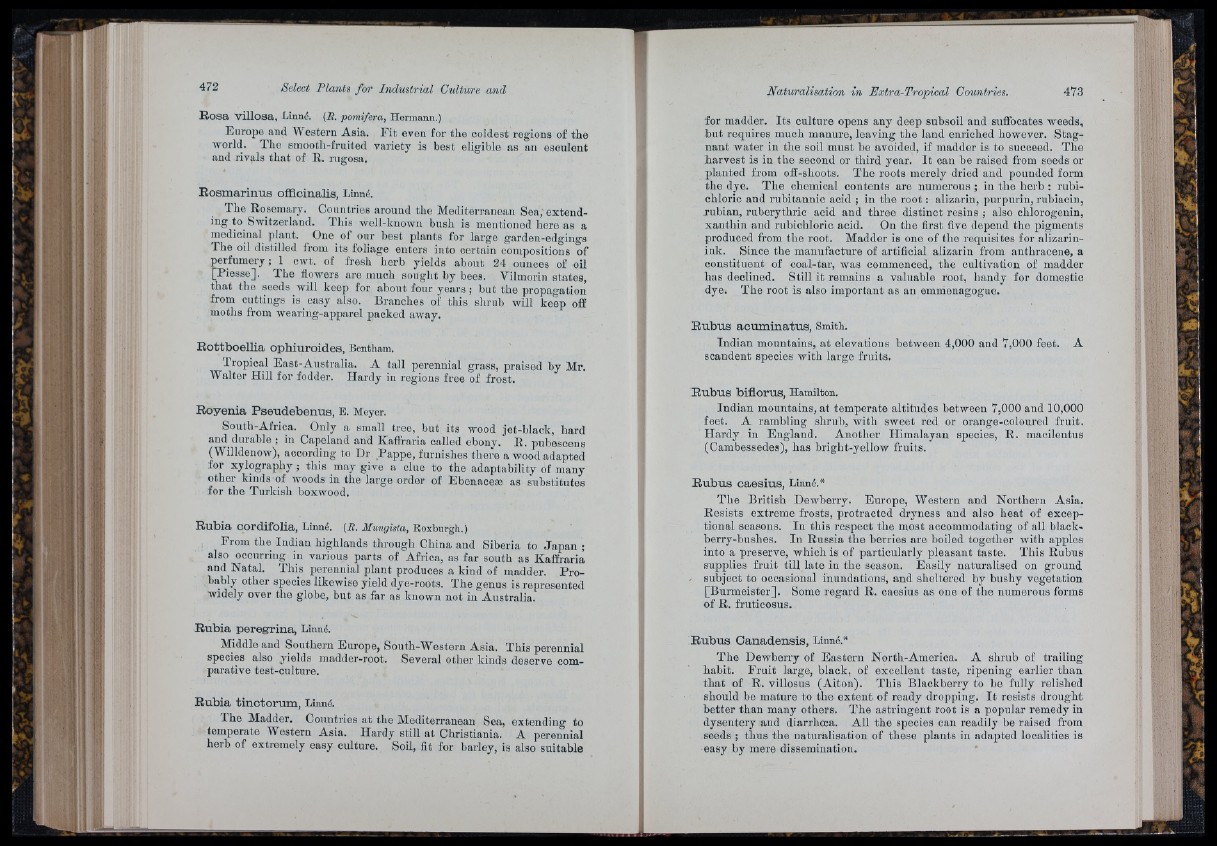
Rosa villosa, Linné. (R. pomífera, Hermann.)
Europe and Western Asia. F it even for the coldest regions of the
world. ïh o smooth-fruited variety is best eligible as an esculent
aud rivals tliat of R. rugosa.
Rosmarinus offlcinalis, Linné.
The Rosemary. Countries around tho Mediterranean Sea, extending
to Switzerland. This well-known bush is mentioned here as a
modiciiial^ plant. One of onr best plants for large garden-edgings
The oil distilled from its foliage enters into certain compositions of
perfumery; 1 cwt. of fresh herb yields about 24 ounces of oil
[Piesse], The flowers are much songlit by bees. Vilmorin states,
th a t tho seeds will keep for about four years ; but the propagation
from cuttings is easy also. Branches of this shrub will keep off
motil 8 from wearing-apparel packed away.
Rottboellia ophiuroides. Bentham.
Tropical East-Australia. A tall perennial grass, praised by Mr.
Walter Hill for fodder. Hardy in regions free of frost.
Royenia Pseudebenus, E. Meyer.
South-Africa. Only a small tree, but its wood jet-black, hard
and dnrahle ; in Capeland and Kaffraria called ebony. E. pubescens
(Willdenow), according to Dr Pappe, furnishes there a wood adapted
for xylograpliy ; this may give a clue to the adaptability of many
other kinds of woods in the large order of Ebenaceoe as substitutes
for the Turkish boxwood.
Rubia cordifolia, Linné. (R. Mmigista, Roxburgh.)
From the Indian highlands through China and Siberia to Jap an ;
also oocnrring in various parts of Africa, as far south as Kaffraria
and Natal. This perennial plant produces a kind of madder. P ro bably
other species likewise yield dye-roots. The genus is represented
widely over the globe, but as far as known not in Australia.
Rubia peregrina, Linné.
Middle aud Southern Europe, South-Western Asia. This perennial
species also yields madder-root. Several other kinds deserve comparative
test-culture.
Rubia tinctorum, Linné.
The Madder. Countries a t the Mediterranean Sea, extending to
temperate Western Asia. Hardy still at Christiania. A perennial
herb of extremely easy culture. Soil, fit for barley, is also suitable
for madder. Its culture opens any deep subsoil and suffocates weeds,
but requires much manure, leaving the land enriolied liowever. Stagnant
water in the soil must be avoided, if madder is to succeed. The
harvest is iu the second or third year. I t can be naised from seeds or
planted from off-slioots. Tho roots merely dried and pounded form
the dye. The chemical contents aro numerous ; in the herb : rubi-
chloric and rubitannic aoid ; in the ro o t: alizarin, pnrpurin, rnbiaoin,
rubian, ruborythric acid and three distinct resins ; also clilorogenin,
xanthin aud rubichloric aoid. On the first five depend the pigments
produced from the root. Madder is ono of the requisites for alizarin-
ink. Since tlie manufacture of artificial alizarin from anthracene, a
constituent of coal-tar, was commenced, tho cultivation of madder
has declined. Still it remains a valuable root, handy for domestic
dye. The root is also important as an emmenagogue.
Rubus acuminatus, Smith.
Indian mountains, a t elevations between 4,000 and 7,000 feet. A
scandent species with large fruits.
Rubus biflorus, Hamilton.
Indian monntains, at temperate altitudes between 7,000 and 10,000
feet. A rambling shruli, with sweet red or orange-coloured fruit.
Hardy in England. Another Himalayan species, R. macilentus
(Cambessedes), has bright-yellow fruits.
Rubus caesius, Linné.*
The British Dewberry. Europe, Western aud Northern Asia.
Resists extreme frosts, protracted dryness and also heat of exceptional
seasons. In this respect the most accommodating of all black-
hcrry-bushes. In Russia the berries are boiled together with apples
into a preserve, which is of particularly pleasant taste. This Rubus
supplies fruit till late in the season. Easily naturalised on ground
• subject to occasional inundations, and sheltered by bushy vegetation
[Burmeister]. Some regard E. caesius as one of the numerous forms
of R. fruticosns.
Rubus Canadensis, Linné.*
The Dewberry of Eastern North-Amerioa. A shrub of trailing
habit. Fru it large, black, of excellent taste, ripening earlier than
th a t of E. villosus (Aiton). This Blackberry to be fully relished
should be mature to the extent of ready dropping. I t resists drought
better than many others. The astringent root is a popular remedy in
dysentery and diarrhoea. All the species ean readily be raised from
seeds ; thus the naturalisation of tliese plants in adapted localities is
easy by mere dissemination.